Jennifer Bohnhoff's Blog, page 25
August 14, 2021
The Symbolism of Poppies
 Fallaner, CC BY-SA 4.0 , via Wikimedia Commons Although poppies are the birthday flower for those born in August, they are most frequently associated with World War I and remembering the soldiers who died during that war. The use of poppies as symbols of death is far older than the early twentieth century. It stretches far back, into ancient times.
Fallaner, CC BY-SA 4.0 , via Wikimedia Commons Although poppies are the birthday flower for those born in August, they are most frequently associated with World War I and remembering the soldiers who died during that war. The use of poppies as symbols of death is far older than the early twentieth century. It stretches far back, into ancient times.The ancient Greeks connected poppies with sleep because of the sedative nature of its sap. After her daughter Persephone was abducted by Hades, the gods gave Demeter, the goddess of harvest, a poppy to help her sleep. Afterwards, poppies sprang from Demeter’s footsteps. She transformed her mortal lover, Mecon, into a poppy.
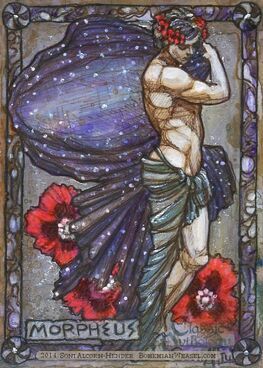 Morpheus, the Greek god of dreams, is frequently represented with poppies. The drug morphine, which is derived from poppies, got its name from Morpheus. Nyx, the god of night, is also associated with poppies. Hypnos, the god of sleep, and his twin brother Thanatos, the god of death, wore crowns of poppies.
Morpheus, the Greek god of dreams, is frequently represented with poppies. The drug morphine, which is derived from poppies, got its name from Morpheus. Nyx, the god of night, is also associated with poppies. Hypnos, the god of sleep, and his twin brother Thanatos, the god of death, wore crowns of poppies. Death and sleep have been intertwined concepts for a long time. In the Bible, Daniel 12:2 describes the dead as "those who sleep in the dust of the earth.” Shakespeare has Hamlet compare sleep to death (line 72).
Victorians decorated tombstones with poppies representing eternal sleep.
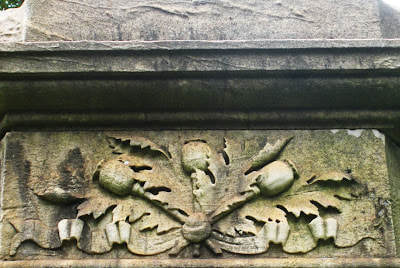
 The association between poppies and sleep continues today. In The Wizard of Oz, Dorothy, Toto and two of her companions fall asleep crossing a field of poppies. In the movie version, the Witch of the West casts a spell over a poppy field. The book, however, explains that the field itself has the power to make cause sleep:
The association between poppies and sleep continues today. In The Wizard of Oz, Dorothy, Toto and two of her companions fall asleep crossing a field of poppies. In the movie version, the Witch of the West casts a spell over a poppy field. The book, however, explains that the field itself has the power to make cause sleep:
“They now came upon more and more of the big scarlet poppies, and fewer and fewer of the other flowers; and soon they found themselves in the midst of a great meadow of poppies. Now it is well known that when there are many of these flowers together their odor is so powerful that anyone who breathes it falls asleep, and if the sleeper is not carried away from the scent of the flowers he sleeps on and on forever. But Dorothy did not know this, nor could she get away from the bright red flowers that were everywhere about; so presently her eyes grew heavy and she felt she must sit down to rest and to sleep.” –L. Frank Baum, The Wizard of Oz Poppies became associated with World War I because of a poem written by a Canadian doctor who was stationed in Belgium during the war. Lieutenant Colonel John McRae wrote In Flanders Fields, which talks about the poppies growing among the new grave markers, on May 3, 1915 after officiating at the funeral of his friend and brother in arms, Alexis Helmer. His poem was published in Punch Magazine and became an instant sensation.
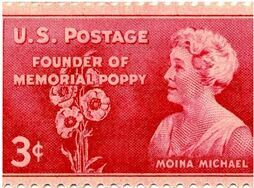 Moina Michael, an American working at the YMCA Overseas War Secretaries Office in New York, read the poem and was so moved that she vowed to wear a poppy on her lapel to honor the men who had died in war. She bought silk poppies for her colleagues, then lobbied to have the poppy adopted as a symbol of national remembrance.
Moina Michael, an American working at the YMCA Overseas War Secretaries Office in New York, read the poem and was so moved that she vowed to wear a poppy on her lapel to honor the men who had died in war. She bought silk poppies for her colleagues, then lobbied to have the poppy adopted as a symbol of national remembrance.At the same time, a French woman Anna Guérin was also promoting silk poppies. The director of the “American and French Children’s League,” Ms. Guérin adopted the poppy as the charity’s emblem. The charity provided war veterans, women, and children with fabric to make artificial poppies, which were then sold to help fund the rebuilding of war-torn regions of France and to assist orphaned children. In Britain, a similar campaign raised money to help Veterans in find employment and housing.
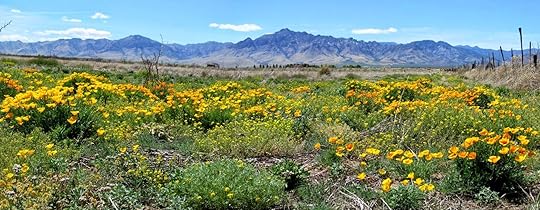 The poppies that grew in the fields of Flanders were blood red. The poppies that grow in Southern New Mexico, when my novel
A Blaze of Poppies
begins and ends, are the bright yellow Mexican poppy. Southern New Mexico is part of the Chihuahuan Desert, the largest desert in North America. It receives between six and sixteen inches of rain a year. When the spring rains come, parts of the dry, brown desert explode into fields of brilliant yellow poppies. If red poppies remind man of sleep, death, and remembering the dead, the bright Mexican poppies must surely symbolize the renewal of life in all its brilliance and hope.
The poppies that grew in the fields of Flanders were blood red. The poppies that grow in Southern New Mexico, when my novel
A Blaze of Poppies
begins and ends, are the bright yellow Mexican poppy. Southern New Mexico is part of the Chihuahuan Desert, the largest desert in North America. It receives between six and sixteen inches of rain a year. When the spring rains come, parts of the dry, brown desert explode into fields of brilliant yellow poppies. If red poppies remind man of sleep, death, and remembering the dead, the bright Mexican poppies must surely symbolize the renewal of life in all its brilliance and hope.Agnes Day, the main character in A Blaze of Poppies begins her story on a ranch in the dry New Mexican desert. It leads her to the field hospitals of France, where she witnesses the death and destruction of war first hand. But it is poppies that blaze the trail back to her beloved ranch. Jennifer Bohnhoff is a former history teacher who lives in the mountains of central New Mexico. Her novel A Blaze of Poppies is due out in October, 2021 and is currently available for preorder.
Published on August 14, 2021 23:00
August 10, 2021
A Poem for a Horse
A Soldier’s Kiss 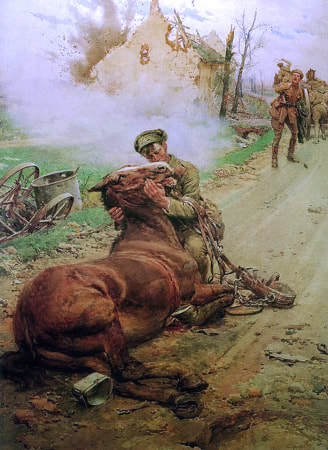 'Goodbye, Old Man,' by Fortunino Matania Only a dying horse! pull off the gear,
'Goodbye, Old Man,' by Fortunino Matania Only a dying horse! pull off the gear,
And slip the needless bit from frothing jaws,
Drag it aside there, leaving the road way clear,
The battery thunders on with scarce a pause.
Prone by the shell-swept highway there it lies
With quivering limbs, as fast the life-tide fails,
Dark films are closing o'er the faithful eyes
That mutely plead for aid where none avails.
Onward the battery rolls, but one there speeds
Heedlessly of comrades voice or bursting shell,
Back to the wounded friend who lonely bleeds
Beside the stony highway where he fell.
Only a dying horse! he swiftly kneels,
Lifts the limp head and hears the shivering sigh
Kisses his friend, while down his cheek there steals
Sweet pity's tear, "Goodbye old man, Goodbye".
No honours wait him, medal, badge or star,
Though scarce could war a kindlier deed unfold;
He bears within his breast, more precious far
Beyond the gift of kings, a heart of gold.
by Henry Chappell Known as the Railway Porter Poet because he worked at Bath Railway Station, Henry Chappell (1874 - 1937) is most known for a WWI poem entitled "The Day." A collection of his poems is available as a free download here.
Fortunio Matania (1881–1963) was an Italian artist noted for his realistic portrayal of World War I trench warfare and other historical scenes.
Jennifer Bohnhoff is a writer who lives in the mountains of central New Mexico. Her historical novel about World War I, A Blaze of Poppies, will be released this fall and is available for preorder.
 'Goodbye, Old Man,' by Fortunino Matania Only a dying horse! pull off the gear,
'Goodbye, Old Man,' by Fortunino Matania Only a dying horse! pull off the gear,And slip the needless bit from frothing jaws,
Drag it aside there, leaving the road way clear,
The battery thunders on with scarce a pause.
Prone by the shell-swept highway there it lies
With quivering limbs, as fast the life-tide fails,
Dark films are closing o'er the faithful eyes
That mutely plead for aid where none avails.
Onward the battery rolls, but one there speeds
Heedlessly of comrades voice or bursting shell,
Back to the wounded friend who lonely bleeds
Beside the stony highway where he fell.
Only a dying horse! he swiftly kneels,
Lifts the limp head and hears the shivering sigh
Kisses his friend, while down his cheek there steals
Sweet pity's tear, "Goodbye old man, Goodbye".
No honours wait him, medal, badge or star,
Though scarce could war a kindlier deed unfold;
He bears within his breast, more precious far
Beyond the gift of kings, a heart of gold.
by Henry Chappell Known as the Railway Porter Poet because he worked at Bath Railway Station, Henry Chappell (1874 - 1937) is most known for a WWI poem entitled "The Day." A collection of his poems is available as a free download here.
Fortunio Matania (1881–1963) was an Italian artist noted for his realistic portrayal of World War I trench warfare and other historical scenes.
Jennifer Bohnhoff is a writer who lives in the mountains of central New Mexico. Her historical novel about World War I, A Blaze of Poppies, will be released this fall and is available for preorder.
Published on August 10, 2021 23:00
August 7, 2021
Back to School: Cookies and Teachers
 It’s August, which should mean high summer.
It’s August, which should mean high summer.For many of us, though, school is starting. Here in the mountains of New Mexico, the sunflowers start to bloom about the same time the school bells start to ring, and the smell of chili roasting wafts on the air. All of these are signs that summer is on the wane and fall is coming.
These cookies really have a bit of a fall feel to them. The molasses gives them an earthy, satisfying taste that calls me home. Time to settle in and enjoy the last of the season before fall, with all its activities, starts again.
Molasses Chocolate Crinkles
½ cup (1 stick) butter, softened
½ cup molasses
½ cup cocoa
¼ cup sugar
1 tsp baking soda
1 tsp cinnamon
1 tsp vanilla
¼ tsp salt
1 ½ cups flour
Topping: ¼ cup powdered sugar
Heat oven to 350
Beat all ingredients except flour until mixed.
Add flout just until blended
Form into 1: balls and roll in sugar
Place 1” apart on cookie sheet
Bake 9-10 minutes until puffed and cracked.
Cool 1 minute before removing from cookie sheet.
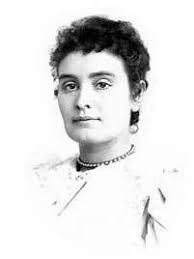 Over the years, there have been many outstanding teachers in the history of the USA. They worked to make the world a better place by improving the educational system and teaching practices. Their contribution changed the whole perception of education and shaped our society. Here are famous educators who have made a difference in the world.
Over the years, there have been many outstanding teachers in the history of the USA. They worked to make the world a better place by improving the educational system and teaching practices. Their contribution changed the whole perception of education and shaped our society. Here are famous educators who have made a difference in the world.Anne Sullivan
Anne Sullivan reimagined special education, using her experience and natural pedagogical talent. She is famous for being a teacher of Helen Keller, a deaf and blind girl. Anne became her educator and eventually a friend. Being visually impaired herself, Sullivan knew what the girl was experiencing. It allowed her to choose special teaching techniques to help Hellen communicate with the world. Anne would take her hand and spell each word on the girl’s palm. This creative method proved to be effective, and soon, Hellen learned more and more words. With Anne’s help, Helen Keller became a well-known author, political activist, and the first blind-deaf person to earn a bachelor’s degree.
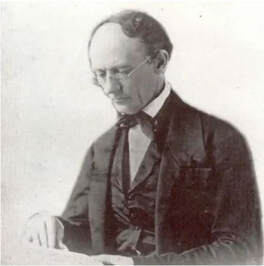
William McGuffey
William McGuffey was born in 1800 and was such a precocious child that he began to teaching classes at age 14. While teaching in Ohio and Kentucky, McGuffey saw that there was no standard method to teach students how to read; often, the Bible was the only book available.
McGuffey paused his teaching career to attend college himself. By age 26, he was Professor of Languages at Miami University in Oxford, Ohio. In 1835, his friend Harriet Beecher Stowe asked him to write a series of readers for the publisher Truman and Smith. McGuffey Readers, a series of books for elementary school students, was used in American schools for the next 70 years.
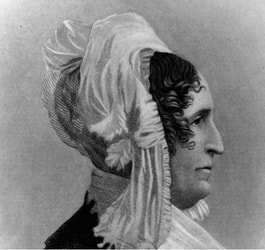 Emma Willard
Emma WillardEmma Willard made education accessible for women. She founded the first higher education institution for females in America, the Troy Female Seminary. The school still exists as the Emma Willard School. Emma Willard made the promotion of education her life-long aim. She fought for women’s rights to achieve higher education of the same quality as men could get. In her institution, female students studied science, mathematics, philosophy, and other subjects that were not previously available to them. Willard’s progressive outlook prioritized equality changed the perspective people had on education. Vivian Paley
Vivian Paley was a preschool teacher and the author of numerous books. She emphasized the importance of storytelling and play for the development of children. Paley believed that teachers who promoted fantasy and make-believe evoked the most interest in their students. She made her lessons memorable for students and encouraged them to express feelings and ideas in the classroom. Vivian Paley received numerous awards acknowledging her contribution to preschool teaching.
Sal Khan
Sal Khan tried to make education more accessible to people around the world. This American educator founded the Khan Academy, and online platform that granted people access to educational topics. It covers many different school subjects, including math, computing, history, and the arts. His use of technologies revolutionized education.
 Jennifer Bohnhoff taught English, Social Studies and History at the middle school and high school level. She is now retired so that she can devote her time to writing historical novels.
Jennifer Bohnhoff taught English, Social Studies and History at the middle school and high school level. She is now retired so that she can devote her time to writing historical novels.
Published on August 07, 2021 23:00
August 3, 2021
DULCE ET DECORUM EST
 Gassed, by John Singer Sergeant Bent double, like old beggars under sacks,
Gassed, by John Singer Sergeant Bent double, like old beggars under sacks,Knock-kneed, coughing like hags, we cursed through sludge,
Till on the haunting flares we turned our backs,
And towards our distant rest began to trudge.
Men marched asleep. Many had lost their boots,
But limped on, blood-shod. All went lame; all blind;
Drunk with fatigue; deaf even to the hoots
Of gas-shells dropping softly behind.
Gas! GAS! Quick, boys!—An ecstasy of fumbling
Fitting the clumsy helmets just in time,
But someone still was yelling out and stumbling
And flound’ring like a man in fire or lime.--
Dim through the misty panes and thick green light,
As under a green sea, I saw him drowning.
In all my dreams before my helpless sight,
He plunges at me, guttering, choking, drowning.
If in some smothering dreams, you too could pace
Behind the wagon that we flung him in,
And watch the white eyes writhing in his face,
His hanging face, like a devil’s sick of sin;
If you could hear, at every jolt, the blood
Come gargling from the froth-corrupted lungs,
Obscene as cancer, bitter as the cud
Of vile, incurable sores on innocent tongues,--
My friend, you would not tell with such high zest
To children ardent for some desperate glory,
The old Lie: Dulce et decorum est
Pro patria mori.
 Wilfred Owen was a sensitive young man who considered joining the clergy. He volunteered to help the poor and sick in his parish until the tepid response of the Church of England to the sufferings of the underprivileged and dispossessed disillusioned him. He then taught in France for two years, returning to England and joining the army after the war began. Owen's first few letters home to his mother in the early winter of 1916 indicate that he was enamored with the glamor and excitement of war, but in less than a month reality had taken hold and he had seen enough. The events depicted in "Dulce et Decorum Est" occurred on January 12, 1917. By then, he was ready to deny Horace's Latin admonition to the Romans that it was sweet and good to die for one's country. Owen died on November 4, 1918, just days before the war ended.
Wilfred Owen was a sensitive young man who considered joining the clergy. He volunteered to help the poor and sick in his parish until the tepid response of the Church of England to the sufferings of the underprivileged and dispossessed disillusioned him. He then taught in France for two years, returning to England and joining the army after the war began. Owen's first few letters home to his mother in the early winter of 1916 indicate that he was enamored with the glamor and excitement of war, but in less than a month reality had taken hold and he had seen enough. The events depicted in "Dulce et Decorum Est" occurred on January 12, 1917. By then, he was ready to deny Horace's Latin admonition to the Romans that it was sweet and good to die for one's country. Owen died on November 4, 1918, just days before the war ended.  The memorial in front of where Wilfred's old school, Birkenhead Institute, once stood. 88 of its students, including Wilfred, died in WWI. Jennifer Bohnhoff's World War I novel, A Blaze of Poppies, will be published in October 2021. It can be preordered here.
The memorial in front of where Wilfred's old school, Birkenhead Institute, once stood. 88 of its students, including Wilfred, died in WWI. Jennifer Bohnhoff's World War I novel, A Blaze of Poppies, will be published in October 2021. It can be preordered here.
Published on August 03, 2021 23:00
July 31, 2021
Fort Bayard: Southern New Mexico Site
 I've written about Fort Bayard's history before. You can read all about it here.
I've written about Fort Bayard's history before. You can read all about it here. Fort Bayard has been on my mind a lot lately. I had intended to go down and revisit it during spring break this year. Travel restrictions surrounding the COVID-19 pandemic put a stop to that. So, instead, I did as much research as I could online. I found some good information, but nothing is as good as actually being in a place.
Fort Bayard ceased to be a military post when the last detachment of the 9th U.S. Cavalry departed on January 12, 1900. That doesn't mean that the site was abandoned. The War Department had already issued an order issued on August 28, 1899 that authorized the Surgeon General to establish the first military sanatorium dedicated to the treatment of Army officers and enlisted men suffering from pulmonary tuberculosis. Major Daniel M. Appel, an Army surgeon, arrived at Fort Bayard on October 3, 1899 to organize the hospital.
Fort Stanton had undergone a similar conversion, becoming a sanatorium for tubercular merchant seamen in April 1899. Fort Stanton was transferred to the Department of Interior in 1896, and then to the U.S. Marine Hospital Service, a bureau within the Treasury Department, in 1899, Fort Bayard remained within the Army under the auspices of the Army Medical Department.
. The Spanish-American War. drove the need for sanatorium for the Army's soldiers and veterans. In the humid, tropics of Cuba, more soldiers succumbed to disease than enemy fire. Many soldiers serving in the Philippines returned with pulmonary disease. At 6,100 ft. and with a dry, sunny climate, Fort Bayard seemed a perfect place to restore health to diseased lungs. Fresh air and sunshine was considered so important to healing that patients who were ambulatory stayed outdoors at least eight hours daily throughout the entire year, and dormitory windows remained open. By March 1902, over 600 patients had been treated at the sanatorium.
World War I created another upsurge in the need for a hospital dedicated specifically to injuries and illnesses of the lungs. The cold, damp trenches of Northern France were breeding grounds for pneumonia, and gas warfare damaged thousands of dough boy lungs. The Great Influenza of 1918-19, often referred to as the Spanish Flu, also contributed to pulmonary disease.
By 1920, the Army involvement with medicine for veterans was changing. In May the War Department closed the sanatorium and transferred most of its corpsmen, physicians and patients to other facilities in an effort to consolidate services. Most patients were moved to Denver.
 Jennifer Bohnhoff lives in the mountains of central New Mexico and writes historical fiction. Her novel, A Blaze of Poppies, is set in Southern New Mexico and France during the 1910s. Some of the action takes place at Fort Bayard. Available October 2021, you can preorder this book now.
Jennifer Bohnhoff lives in the mountains of central New Mexico and writes historical fiction. Her novel, A Blaze of Poppies, is set in Southern New Mexico and France during the 1910s. Some of the action takes place at Fort Bayard. Available October 2021, you can preorder this book now.
Published on July 31, 2021 23:00
July 27, 2021
In Flanders Fields
 In Flanders Fields In Flanders fields the poppies blow
In Flanders Fields In Flanders fields the poppies blowBetween the crosses, row on row,
That mark our place, and in the sky,
The larks, still bravely singing, fly,
Scarce heard amid the guns below.
We are the dead; short days ago
We lived, felt dawn, saw sunset glow,
Loved and were loved, and now we lie
In Flanders fields.
Take up our quarrel with the foe!
To you from failing hands we throw
The torch; be yours to hold it high!
If ye break faith with us who die
We shall not sleep, though poppies grow
In Flanders fields.
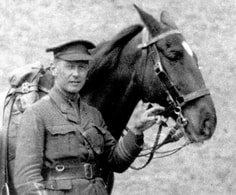 The author of perhaps the most recognized poem of World War I was not an English schoolboy with romantic ideas about going off to war. Lt. Col. John McCrae was a Canadian surgeon. He had previously served in the Boer War in South Africa and knew the horrors of war first hand.
The author of perhaps the most recognized poem of World War I was not an English schoolboy with romantic ideas about going off to war. Lt. Col. John McCrae was a Canadian surgeon. He had previously served in the Boer War in South Africa and knew the horrors of war first hand.McCrae served in a field hospital that sat close by the Yser Canal in Ypres, Belgium. On May 2, 1915, McCrae had to officiate at the battlefield funeral of Lt. Alexis Helmer a 22-year-old close friend. from Ottawa who seved with the Canadian First Artillery. Helmer been blown to bits by an eight-inch German shell launched from the other side of the canal.
The next day, McCrae penned his famous poem while sitting on the back bumper of an ambulance that overlooked the make-shift cemetery. He was inspired by the poppies that grew among the wooded crosses.
McCrae did not live to see the end of the war. He died of pneumonia in 1916. Jennifer Bohnhoff's novel about World War I will be published in October 2021. You can preorder A Blaze of Poppies here. To learn more about John McCrae, click here.
Published on July 27, 2021 23:00
July 24, 2021
Americans buried in the Somme
 The Somme district is a part of Picardie, in Northern France. It is a beautiful area of green, gently rolling hills and little stands of woods. The American Somme Cemetery is there not because of the area’s beauty, but because it was the scene of some of the bloodiest fighting in World War I.
The Somme district is a part of Picardie, in Northern France. It is a beautiful area of green, gently rolling hills and little stands of woods. The American Somme Cemetery is there not because of the area’s beauty, but because it was the scene of some of the bloodiest fighting in World War I.  The cemetery’s chapel boasts a massive bronze door surmounted by an American eagle. Its outer walls are carved with military equipment. Inside a cross-shaped crystal window illuminates walls which bear the names of 333 men missing in action.
The cemetery’s chapel boasts a massive bronze door surmounted by an American eagle. Its outer walls are carved with military equipment. Inside a cross-shaped crystal window illuminates walls which bear the names of 333 men missing in action.Outside, rows of crosses and stars of David mark the graves of 1,844 American men and women who fell trying to break the Hindenburg line, which bisected the area, in a push known as the The Hundred Days Offensive.
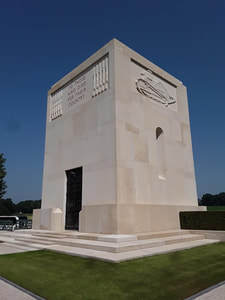 Most buried there served in American units attached to the British Fourth Army under the overall command of General Sir Henry Rawlinson. Others buried there died in operations near Cantigny.
Most buried there served in American units attached to the British Fourth Army under the overall command of General Sir Henry Rawlinson. Others buried there died in operations near Cantigny.The largest one-day American regimental loss of the entire war occurred here on September 29, 1918 when the 107th Infantry Regiment suffered nearly 1,000 casualties during the first day’s attack in the Battle of St Quentin Canal.
Three Medal of Honor recipients are buried here. The Gold Star Mothers became organized because of two brothers, James and Harmon Vedder, who are buried side by side.
Not all buried here were fighters. Nurse Helen Fairchild was serving in a casualty clearing station in Dozinghem during July and August, while the Third Battle of Ypres-Passchendaele was happening nearby. The station was repeatedly exposed to mustard gas and heavy shelling, and she reportedly loaned her gas mask to a wounded soldier during one such attack. After being evacuated in August, she developed gastric ulcers, for which she underwent surgery on January 13, 1918. She lapsed into a coma and died five days later. It remains unsure whether Helen Fairchild died of complications from chloroform used during surgery or from effects of mustard gasses, which mimic the effects chloroform has on the stomach.
Jennifer Bohnhoff toured this cemetery in June 2019 as part of a tour of World War I battlefields. A Blaze of Poppies, her novel based on her experiences will come out in October and is now available for preorder.
For more information on Mrs. Bohnhoff and her writing, visit her website.
Published on July 24, 2021 23:00
July 22, 2021
All American Breakfast
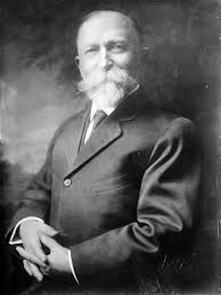 Dr. John Harvey Kellogg Breakfast in America in the mid-1800s was not all that different from other meals. Middle- and upper-class Americans ate eggs, pastries, and pancakes like we do today, but oysters, boiled chicken, beefsteaks and leftovers were also on the menu. It wasn’t until the invention of ready-to-eat cereal that breakfast became a meal with distinct foods that weren’t usually served at other times of day.
Dr. John Harvey Kellogg Breakfast in America in the mid-1800s was not all that different from other meals. Middle- and upper-class Americans ate eggs, pastries, and pancakes like we do today, but oysters, boiled chicken, beefsteaks and leftovers were also on the menu. It wasn’t until the invention of ready-to-eat cereal that breakfast became a meal with distinct foods that weren’t usually served at other times of day.The men behind this transformation have names that are still recognized today. Dr. John Harvey Kellogg and C.W. Post began a transformation in what Americans eat that is still controversial today.
During the nineteenth century, the most common American digestive complaint was dyspepsia, a term for what we now call indigestion. Dr. Kellogg and other nutritionists and reformers attributed this complaint to eating a diet too heavy in meat and spices and to too little exercise. They recommended what Kellogg called “biologic living,” a vegetarian lifestyle with more exercise, simple, unspiced foods, and whole grains. One dietary reformer, Sylvester Graham, invented the graham cracker in 1827. In 1863, another reformer named James Caleb Jackson invented a cereal that he named “granula” and his critics called “wheat rocks.” Kellogg invented his corn flakes in 1894.
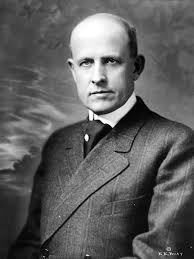 C.W. Post The public responded favorably to these new dietary theories. During its first year in production, more than 50 tons of corn flakes were sold. By 1903, over 100 cereal companies had begun producing breakfast cereals in Kellogg’s home town of Battle Creek, Michigan.
C.W. Post The public responded favorably to these new dietary theories. During its first year in production, more than 50 tons of corn flakes were sold. By 1903, over 100 cereal companies had begun producing breakfast cereals in Kellogg’s home town of Battle Creek, Michigan.One of Kellogg’s biggest competitors was C.W. Post, who formed his own cereal company in 1895. Post became a convert to Kellogg’s theories after being under Kellogg’s care following a nervous breakdown in 1890. Less a reformer than an entrepreneur, his first product, Postum, was a grain-based coffee substitute similar to one Kellogg served his patients. The next year he began manufacturing Grape-Nuts, based on another Kellogg recipe.
Today, the bloom has come off the cereal rose. Americans are more obese than ever before. Tums and other antacid medications show that we still suffer from indigestion. The dietary pendulum has swung to the other extreme, as evidenced by advocates of Keto, paleo and other diets that are meat-centered. Yet, cereal continues to make billions of dollars each year, and it’s not just for breakfast anymore. I’ve been posting a cookie recipe every month, with the ultimate plan of putting together a cookie recipe book for my friends, fans and family at the end of the year.
It’s too hot to bake, though. Here we are, in the middle of summer, and I find the idea of turning on the oven repugnant. Good thing there is such a thing as the no-bake cookie.
If you’ve known me longer than two months, you know that my husband loves cookies and he loves peanut butter. This recipe seems to be one of my go-tos for the indolent days of summer.
Peanut Butter Cereal Treats
 Line a 9” square pan with plastic wrap
Line a 9” square pan with plastic wrapIn a sauce pan, combine ½ cup sugar and ½ cup corn syrup.
Boil 1 minute over medium heat, stirring occasionally. Sugar will melt into the corn syrup and mixture will be clear.
Remove from heat and stir in ½ cup smooth peanut butter
Mix in 4 cups rice krispies cereal
Press into pan. Let cool 15 minutes, then invert on cutting board, remove plastic wrap and cut into squares.
For an extra treat, you can melt ¾ cup semi sweet chocolate chips (I do this in the microwave by putting them in a glass measuring cup and microwaving 30 seconds at a time, stirring between sessions, until melted and smooth) and spreading over the treats when they are still in the pan. If you do this, put the pan in the refrigerator until set solid before turning out and cutting.)
Published on July 22, 2021 23:00
July 17, 2021
Bobbed Hair and Bravery
The main character in my next book, A Blaze of Poppies, is a feisty little woman with more determination than muscle, though she has plenty of that, too. Agnes Day is a third-generation rancher in the dry desert of southwestern New Mexico. She stands barely five feet tall, but she’s adept enough on horseback to rope a steer and bring it down. The fifth daughter in a family that has no sons, she is determined to follow her father and keep the Sunrise Ranch going. 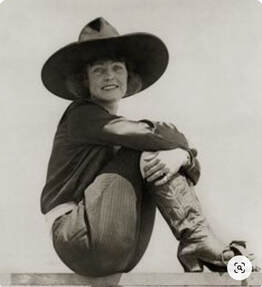
When I write, I amass pictures to help me envision my characters and settings. My inspiration for Agnes Day is a contemporary of hers, an inspiring, real woman named Mabel Strickland. Mabel, who was born in Walla Walla, Washington, in January 1897, learned to ride the same time she was learning to walk. Standing just over five feet tall, she was slim, but muscular enough to throw a 345-pound calf to the ground and pin its flailing legs, a feat that even male cowboys find difficult. She started her riding career when she was only fifteen years old. By 1916, Mabel was competing in rodeos. She continued to compete – and win – for 26 years.
Like Mabel, Agnes Day wears her hair bobbed. One of her suitors, trying to gain her favor says “Bobbed hair like yours is very fashionable now, though. I saw a lot of it on the girls in Boston, where Harvard is. You would fit right in.” Agnes responds with ““I don’t care a continental about fashion, and I don’t care about fitting in,” then watches with satisfaction as the young man blushes. Agnes’ mother then says that “Our Agnes is a practical girl. She bobbed her hair so it won’t get into her eyes when she’s riding.” My grandmother (left) and her sister with their new, modern bobs.
My grandmother (left) and her sister with their new, modern bobs.
While neither a rancher nor a rodeo rider, my own grandmother showed some bravery by getting the same haircut that Mabel Strickland and Agnes Day had. The family story is that she and her sister quietly went into their father’s room when he was sleeping and asked if they could get their hair cut. In his half-asleep state, he assented. The girls then went out and got their hair bobbed, being the first women in Deshler, Nebraska to do so. The family was not happy, but my grandmother and her sister started a trend, and soon many of the girls in town had bobbed hair. Jennifer Bohnhoff is a native New Mexican who lives in the mountains east of Albuquerque. A Blaze of Poppies will be published in October 2021, and is available for preorder here.
Jennifer Bohnhoff is a native New Mexican who lives in the mountains east of Albuquerque. A Blaze of Poppies will be published in October 2021, and is available for preorder here.
To see more images related to this story, visit her Pinterest page.

When I write, I amass pictures to help me envision my characters and settings. My inspiration for Agnes Day is a contemporary of hers, an inspiring, real woman named Mabel Strickland. Mabel, who was born in Walla Walla, Washington, in January 1897, learned to ride the same time she was learning to walk. Standing just over five feet tall, she was slim, but muscular enough to throw a 345-pound calf to the ground and pin its flailing legs, a feat that even male cowboys find difficult. She started her riding career when she was only fifteen years old. By 1916, Mabel was competing in rodeos. She continued to compete – and win – for 26 years.
Like Mabel, Agnes Day wears her hair bobbed. One of her suitors, trying to gain her favor says “Bobbed hair like yours is very fashionable now, though. I saw a lot of it on the girls in Boston, where Harvard is. You would fit right in.” Agnes responds with ““I don’t care a continental about fashion, and I don’t care about fitting in,” then watches with satisfaction as the young man blushes. Agnes’ mother then says that “Our Agnes is a practical girl. She bobbed her hair so it won’t get into her eyes when she’s riding.”
 My grandmother (left) and her sister with their new, modern bobs.
My grandmother (left) and her sister with their new, modern bobs. While neither a rancher nor a rodeo rider, my own grandmother showed some bravery by getting the same haircut that Mabel Strickland and Agnes Day had. The family story is that she and her sister quietly went into their father’s room when he was sleeping and asked if they could get their hair cut. In his half-asleep state, he assented. The girls then went out and got their hair bobbed, being the first women in Deshler, Nebraska to do so. The family was not happy, but my grandmother and her sister started a trend, and soon many of the girls in town had bobbed hair.
 Jennifer Bohnhoff is a native New Mexican who lives in the mountains east of Albuquerque. A Blaze of Poppies will be published in October 2021, and is available for preorder here.
Jennifer Bohnhoff is a native New Mexican who lives in the mountains east of Albuquerque. A Blaze of Poppies will be published in October 2021, and is available for preorder here.To see more images related to this story, visit her Pinterest page.
Published on July 17, 2021 23:00
July 11, 2021
Elizabeth Garrett: Songbird of the Southwest
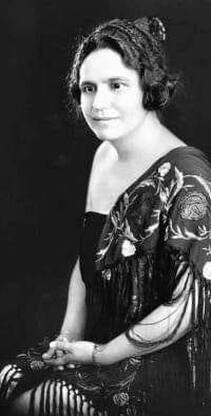 Elizabeth Garrett may not have the name recognition of her famous father, but she deserves to be well known among New Mexicans for her personal bravery and her contributions to her state.
Elizabeth Garrett may not have the name recognition of her famous father, but she deserves to be well known among New Mexicans for her personal bravery and her contributions to her state.Elizabeth’s father was Pat Garret, a bartender, customs agent, and lawman who was sheriff of both Lincoln and Doña Ana Counties in New Mexico. He is most known for killing Billy the Kid, then coauthoring a book titled The Authentic Life of Billy, the Kid, which for decades was considered the most authoritative biography of the famous outlaw.
Pat Garret and his second wife, Apolinaria Gutierrez Garrett had eight children. Elizabeth, the third child, was born on October 9, 1885 in their home in Eagle Creek, outside the small community of Alto, in New Mexico’s Sierra Blanca Mountains. In the same year, the nearby town of Ruidoso was established.
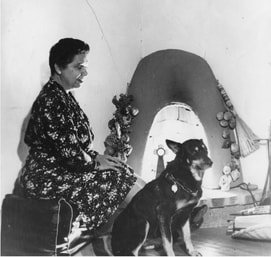 Mrs. Elizabeth Garrett and Teene, her seeing-eye dog, at her 'La Carita' home in Roswell, New Mexico. Courtesy of the Palace of the Governors Photo Archives (NMHM/DCA), 057207. Elizabeth’s life was never easy but she had an independent spirit and a can-do attitude. It is unsure whether she was born blind or lost her sight at an early age. Soon after her birth, the family moved to Roswell, where she led an active outdoor life, riding horses, playing in her family’s apple orchard, and doing all the things the other children did. When she was six, she was sent to the Texas School for the Blind in Austin, where her education included the musical instruction that would guide her future. When she graduated, she rejoined her family, who had moved to El Paso when her father began working as a Customs Officer. When the family moved to Las Cruces, Elizabeth stayed alone in El Paso for three more years so she could continue to teach music there. After that, she moved to Roswell and supervised the building of her dream home, a five-room adobe.
Mrs. Elizabeth Garrett and Teene, her seeing-eye dog, at her 'La Carita' home in Roswell, New Mexico. Courtesy of the Palace of the Governors Photo Archives (NMHM/DCA), 057207. Elizabeth’s life was never easy but she had an independent spirit and a can-do attitude. It is unsure whether she was born blind or lost her sight at an early age. Soon after her birth, the family moved to Roswell, where she led an active outdoor life, riding horses, playing in her family’s apple orchard, and doing all the things the other children did. When she was six, she was sent to the Texas School for the Blind in Austin, where her education included the musical instruction that would guide her future. When she graduated, she rejoined her family, who had moved to El Paso when her father began working as a Customs Officer. When the family moved to Las Cruces, Elizabeth stayed alone in El Paso for three more years so she could continue to teach music there. After that, she moved to Roswell and supervised the building of her dream home, a five-room adobe.Elizabeth composed and sang her own songs at performances around the state and the country. She once performed for the prisoners at New York’s infamous Sing Sing Prison. Her most memorable song is "O, Fair New Mexico," which she wrote in 1915. Two years later, New Mexico Governor Washington E. Lindsey asked her to sing it to the state legislature, who unanimously voted to make it the official state song the very next day.
Elizabeth Garrett died in Roswell on October 16, 1947 after falling while out on a walk. O fair New Mexico Under a sky of azure,
Where balmy breezes blow,
Kissed by the golden sunshine,
Is Nuevo Mejico.
Land of the Montezuma,
With fiery hearts aglow,
Land of the deeds historic,
Is Nuevo Mejico.
O, Fair New Mexico,
We love, we love you so,
Our hearts with pride o’reflow,
No matter where we go.
O, Fair New Mexico,
We love, we love you so,
The grandest state to know
New Mexico.
Rugged and high sierras,
With deep canyons below,
Dotted with fertile valleys,
Is Nuevo Mejico.
Fields full of sweet alfalfa,
Richest perfumes bestow,
State of apple blossoms,
Is Nuevo Mejico.
O, Fair New Mexico,
We love, we love you so,
Our hearts with pride o’reflow,
No matter where we go.
O, Fair New Mexico,
We love, we love you so,
The grandest state to know
New Mexico.
Days that are full of heart-dreams,
Nights when the moon hangs low;
Beaming its benedictions,
O’er Nuevo Mejico.
Land with its bright manana,
Coming through weal and woe;
State of esperanza,
Is Nuevo Mejico.
O, Fair New Mexico,
We love, we love you so,
Our hearts with pride o’reflow,
No matter where we go.
O, Fair New Mexico,
We love, we love you so,
The grandest state to know
New Mexico. "O, Fair New Mexico" is a tango in 2/4 time. I believe New Mexico is the only state that has a tango as its state song. It is in the key of A flat major. Its three stanzas, with refrain, describe the climate, geography, agriculture, and overall beauty of the state of New Mexico. In order to show the two cultures that Ms. Garrett had running in her own veins, each stanza uses the Spanish words "Nuevo México," while the refrain uses "New Mexico."
New Mexicans really like their music, and its legislators like to acknowledge that face. While "O, Fair New Mexico" remains the official state song, the state also has an official Spanish-language state song, a state bilingual song, a state ballad, and an official cowboy song.
 In February 1937, Elizabeth Garrett gave an interview given to Works Progress Administration writer Georgia Redfield, where she said this about her famous father: “Quite frequently,” said Elizabeth Garrett, “my father had to bring harmony with a gun. I try to do so by carrying a tune.” You can read the transcript of the interview here.
In February 1937, Elizabeth Garrett gave an interview given to Works Progress Administration writer Georgia Redfield, where she said this about her famous father: “Quite frequently,” said Elizabeth Garrett, “my father had to bring harmony with a gun. I try to do so by carrying a tune.” You can read the transcript of the interview here.
Jennifer Bohnhoff is a native New Mexican and a former New Mexico history teacher. She lives in the mountains of central New Mexico, where she is presently writing the third in a trilogy of historical novels set in New Mexico during the Civil War. The first in the series, Where Duty Calls," will be published by Kinkajou Press in May 2022.
To read more about her and her writing, click here.
Published on July 11, 2021 00:00



